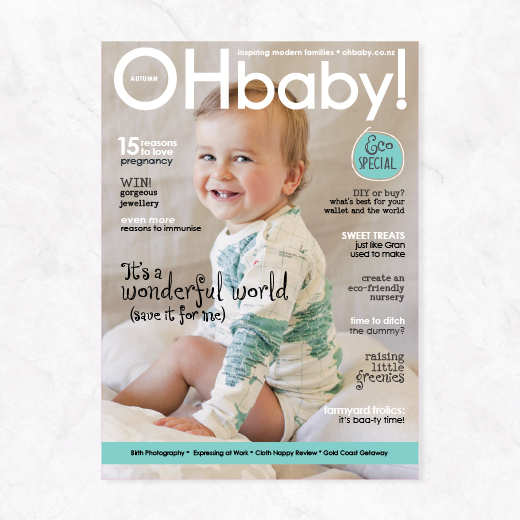Ten fun musical ideas to enjoy with your little one

Make music an everyday part of your familyʼs life with these 10 fun ideas from music specialist Julie Wylie.
You don’t need to be particularly musical to share musical activities with your children. Singing with, not for, children will encourage a natural, playful response. Through self-expression and creativity, children learn about the world around them, and the combination of music and dance is a perfect vehicle for that discovery.
View yourself as a participant rather than a performer. Focus on the activity, not yourself, and take every opportunity to interact playfully and musically with your child. The following are a few ideas to get your family in tune.
1 You can teach the concepts of high and low when climbing up and down stairs. When going up or down stairs sing “Up, up, up, up, up” or “down, down, down, down, down”. It won’t be long before your child is singing himself up and down the stairs.
2 Use the first five notes of the scale for singing up the child’s body so that he learns about pitch in relation to himself: feet, knees, tummy, shoulders and head; and back down again. Or using the numbers on their fingers: one, two, three, four, five, five, four, three, two, one. Try holding that fifth note, especially when you want your child to listen to you singing instructions. This is the child’s natural calling note. It demands attention and puts the brain into a state of high engagement.
3 Nursery rhymes have distinct rhythms. These are based on the natural walking, running, skipping and galloping rhythms of children. For example, if we think of “Humpty Dumpty sat on the wall”, the rhythmic pattern for this line is skip, skip, gallop, walk. Stamp the beat together as you chant or sing the words of nursery rhymes and help develop a strong sense of beat.
4 Set up a range of props in your home for spontaneous musical play such as dress-ups, organza fabric, streamers, a hoop, scarves, puppets, bean bag animals, balloons, a box of musical instruments such as maracas, a set of good quality chime bars and a drum. Also, gather a box of musical treasures together such as “found sounds” like shells and stones picked up on trips to the beach or park.
5 From the moment your child gets up in the morning, singing can support daily routines. Use a simple nursery rhyme such as “Here We Go Round the Mulberry Bush” or “Skip to my Lou” and change the words to fit your step-by-step instructions. Keep the words simple and repetitive and if you find things are getting tedious try changing dynamics (whispering is very effective), changing key if you can, speeding up or slowing down the tempo or adding an element of humour such as holding one note with a dramatic and expectant pause. If you can find that fifth note (think c, d, e, f, G!) this is the most effective note to hold in order to get a child’s whole attention.
6 Introduce your child to a selection of books with rhythmic stories, nursery rhymes, singing games and finger-plays. Authors such as Lynley Dodd, Margaret Mahy, Joy Cowley and AA Milne have wonderful rhythmic stories that can be chanted or sung. Because music and language are so closely related, this type of involvement in singing stories together helps to lay the foundation for your child’s success in language development and reading.
7 The sounds produced by different instruments can initiate an idea for a story. Tapping sticks can be the sound of a ticking clock or the accompaniment for “Hickory Dickory Dock”. Stories such as “Hairy Maclary” can be acted out and each character can have its own particular sound played in time to the words on a drum or other instrument.
8 Go on a sound hunt together. Sit or lie together under a tree and watch and listen to the wind moving through the leaves. Help children develop a “sound picture” of the world around them by encouraging them to listen to the sound produced by scrunching through autumn leaves, listening to raindrops on umbrellas as you walk together in the rain. Make up a song about raindrops using soft, loud, slow and fast. Tap or rub different surfaces, wood, concrete, metal gratings etc. At the beach, listen to the sound of the waves. Ask your child to listen and work out if different sounds are higher, lower, softer or louder than other sounds. The fun and sense of anticipation involved in turn-taking games help your child to develop listening, patterning and sequencing skills.
9 Slow, calming music lowers the heart rate and regulates stressed systems. Young children cannot calm themselves and can become over-aroused when music is too loud, fast, or has too many words. When a child becomes upset, or if it is time for bed, try playing or singing slow, soft lullabies and soothing calming songs. Make up songs about the day or what is happening at bedtime together. Bed-time singing and storytelling not only teaches children about language but can also play a vital part in sharing values, culture and family history.
10 When you and your child are playing and listening together you are helping your child to develop analytical listening skills. Noise is such a feature of modern living that children may have little opportunity to create their own sound environments. Being constantly bombarded by the sound of television or the radio causes children to block out sounds. Relative silence is just as significant as listening to sounds and music so it’s important to give your child quiet times too.
Julie Wylie is Senior Paediatric Music Specialist at the Champion Centre, Early Intervention Trust, in Christchurch and developed her Musical Play philosophy over 30 years in this field. She runs Musical Play classes, training and professional development for teachers and parents. Her work is internationally recognised and her award-winning Sing & PlayCDs have sold all over the world. Go to juliewyliemusic.com for more.

AS FEATURED IN ISSUE 21 OF OHbaby! MAGAZINE. CHECK OUT OTHER ARTICLES IN THIS ISSUE BELOW

















